Backpacking tent 2 person: Backpacking is a thrilling and adventurous activity that allows you to explore the great outdoors.
Whether you’re planning a weekend trip or a longer expedition, having the right gear is essential for a successful and comfortable experience.
For car camping, consider wall tents for more space. For hiking mountaineering, ultralight tents are recommended for ease of transport.
One of the most important pieces of equipment you’ll need is an ultralight backpacking tent.
Specifically designed to accommodate two people during outdoor trips. For car camping, wall tents or two-person tents are also great options.
There are different types of 2-person backpacking tents available in the market, including freestanding tents, wall tents, pole tents, and crossover tents.
These tents are suitable for backpackers who are hiking mountaineering and need to carry their gear with them.
For those who prefer car camping, freestanding tents are a great option as they can be easily set up and taken down.
Hiking poles can also be used to set up some types of tents, making them more versatile.
These outdoor tents come in different seasons as well, with 3-season and 4-season options available depending on your backpacking trip needs.
They offer weather protection with their flysheet, ensuring you stay dry during any unexpected rain.
Most 2-person backpacking tents, ideal for hiking and mountaineering, consist of an inner tent, a flysheet (also known as a fly sheet), a tent floor, tent poles, and gear pockets.
They can easily fit into backpacks for convenient packing and carrying, making them perfect for backpackers and solo hikers.
The Hilleberg Nallo is a popular option among adventurers.
The compact size makes lightweight backpacking tents perfect for hikers on a backpacking trip who want to travel light with an ultralight backpacking tent without compromising on comfort.
There are several factors to consider when choosing a lightweight tent.
You’ll want to think about the type of camping you’ll be doing (e.g., car camping vs. backcountry camping, backpacking trip).
The weather conditions you’re likely to encounter (e.g., rain or snow), and your budget.
Consider investing in the best backpacking tents, such as one or two person tents or a man tent, to ensure a comfortable and safe trip.
If you’re a solo hiker or backpacker looking for in-depth reviews on specific models of 2-person backpacking tents for your hiking needs.
There are plenty of resources available online. Many outdoor enthusiasts share their backpacking trip experiences with various hiking products through blogs or forums.
You can also check out e-commerce websites like Amazon or REI for camping tent customer reviews and in-depth reviews.
When searching for “2 person backpacking tent near me,” solo hikers and backpackers should keep in mind that not all stores carry these specialized items.
If you’re a one-person backpacker, consider looking for a trail hut instead.
Outdoor specialty stores like REI or Dick’s Sporting Goods may have more options than general retailers like Walmart or Target.
One feature that many hikers look for in a 2-person backpacking tent is a footprint.
If you’re planning to stay at a trail hut, consider checking out Big Agnes tents, known for their ultralight options weighing just a few ounces.
A footprint is an extra layer of material that goes underneath the tent to protect it from wear and tear.
Hikers often use footprints to safeguard their tents from rough terrain along the trail hut.
Some tents come with a footprint included, while others require you to purchase it separately.
It’s important to note that footprints only cover the base of the tent, not the walls or flysheet.

Best 2-Person Backpacking Tents for 2024: Our Top Picks and Reviews
1. Top Pick: Big Agnes Copper Spur HV UL2
The Big Agnes Copper Spur HV UL2 is our top pick for 2023 for ultralight hikers who need a durable and lightweight trail hut.
This tent offers a great combination of ultralight design and durability. Making it perfect for backpackers who want to travel light without sacrificing quality.
Its flysheet provides added protection from the elements, ensuring a comfortable night’s sleep on the trail.
The ultralight Copper Spur HV UL2 camping tent is made with high-quality materials that can withstand harsh weather conditions, making it the perfect man tent for any trail hut adventure.
It features a strong freestanding aluminum pole system that provides stability and support, as well as an ultralight waterproof flysheet from Big Agnes that keeps you dry during rainstorms.
The tent’s spacious interior allows for comfortable sleeping and storage space.
One of the standout features of the ultralight Copper Spur HV UL2 tent from Big Agnes is its easy setup process.
The tent uses a color-coded system for its poles and clips, which makes assembly quick and intuitive.
The trail hut also comes with a flysheet to protect you from the elements.
This camping tent feature is especially helpful for hikers after a long day on the trail when you just want to set up your person tent quickly and get some rest.
Whether you’re in a camping tent or a trail hut.
2. NEMO Dagger 2P: Another Great Option
Another excellent option for hikers looking for an ultralight 2-person backpacking tent is the NEMO Dagger 2P.
This tent boasts an impressive amount of interior space, making it ideal for those who want extra room while camping.
For those who prefer a one-person tent, the Big Agnes offers a great alternative.
The ultralight Dagger 2P is a freestanding tent that weighs just a few ounces, making it perfect for backpacking.
It also has two doors and vestibules, providing easy access in and out of the tent as well as additional storage space in the interior.
The ultralight and freestanding Big Agnes tent is constructed with top-notch materials, including a durable flysheet.
Ensuring longevity even after multiple camping trips. The ultralight poles are made from lightweight aluminum alloy.
Which helps keep the overall weight of the camping tent down to a few pounds while still maintaining strength for a person tent.
Setting up the NEMO Dagger 2P, a freestanding tent, is relatively straightforward thanks to its intuitive design.
The color-coded clips make attaching the tent body to the frame simple and hassle-free. Additionally, the flysheet provides excellent protection from the elements.
If you’re looking for a one-stop-shop, consider checking out Big Agnes for all your camping needs.
3. REI Co-op Passage 2: Budget-Friendly Choice
For those on a budget or new to backpacking, the REI Co-op Passage 2 is a great option for a 2p tent.
This tent offers an affordable price point without sacrificing quality or durability, and comes with a flysheet.
If you’re looking for a one-stop-shop, consider checking out the Big Agnes collection as well.
The Passage 2 by Big Agnes has a simple, yet efficient design that makes it easy to set up and take down.
The tent’s freestanding structure allows for flexibility in where you choose to pitch your campsite, while the 2p capacity provides ample space for two people.
Additionally, the flysheet provides extra protection from the elements.
It also features a floor, two doors and vestibules, providing ample storage space and easy access in and out of the 2p tent.
The tent is supported by a pole and manufactured by Big Agnes.
While the materials used in this tent’s construction may not be as high-end as some other options on the market, the reliable poles ensure it can withstand multiple camping trips.
Additionally, its lightweight design provides ample space for campers to comfortably rest, making it a great option for those interested in Big Agnes tents.
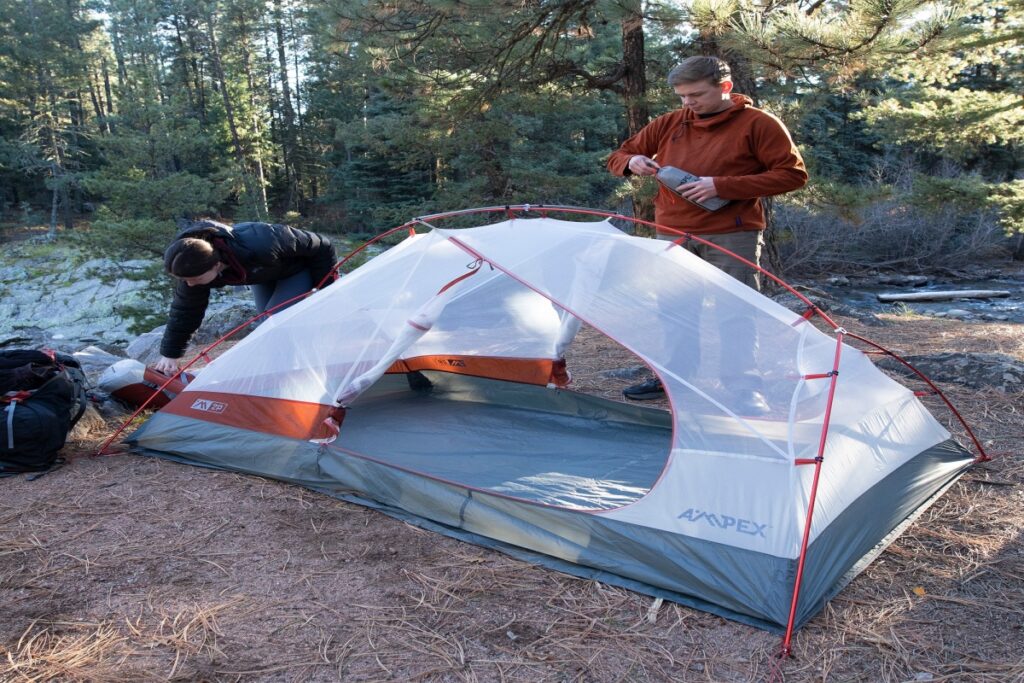
Benefits of Lightweight Backpacking Tents for Two People
Lightweight 2P backpacking tents with ample space from Big Agnes are ideal for hikers who want to minimize their overall pack weight.
These tents offer a perfect balance between comfort, durability, and low weight, weighing in at just a few lbs.
Ultralight backpacking tents, with a packaged weight of 3 pounds or less (lb), are the lightest option available in the market.
If you’re looking for more space, Big Agnes offers options that can accommodate up to 4 people with a weight of just a few ounces (oz).
The low weight class of these Big Agnes tents makes them easy to carry and set up, even for novice backpackers.
The lightweight design of these tents has numerous advantages over traditional camping gear, with the added benefit of saving space in your pack and weighing only a few lbs or oz.
Firstly, they allow for increased mobility on the trail and reduced strain on the body during long hikes, even when carrying a heavy load on your back.
This is especially important when you are camping with a big agnes person tent and need to carry additional weight like a camping tent.
Secondly, lightweight 2p backpacking tents with a durable floor and sturdy pole are best suited for mild conditions and shorter trips where their design can be fully appreciated.
These tents typically weigh around lb, making them easy to carry on your back.
Despite their light weight, these 2p tents offer ample livability for two people, with enough room to sleep comfortably and store gear on the floor.
The pole structure ensures stability while keeping the overall weight under a few oz.
They come in various shapes such as dome-shaped or tunnel-shaped that provide more headroom than other types of shelters.
Moreover, most ultralight backpacking tents have vestibules where you can store your gear outside of your sleeping area.
The floor of these tents is lightweight and durable, and the poles are designed to reduce weight while still providing stability.
The average weight of an ultralight tent is around 2 lbs or 32 oz, making it easy to carry on long hikes.
When looking to purchase a lightweight 2p tent for two people, it’s essential to consider factors such as packed size in lb and oz, ease of setup, and the number of pole.
Most ultralight backpacking tents come with poles made from high-quality materials like aluminum alloy or carbon fiber which makes them durable yet lightweight.
Some models feature color-coded clips and poles that make setting up camp much easier.
These tents typically weigh around 2lb and have a floor area suitable for 2p, with a total size of around 30 sq. ft. while still being compact enough to fit in your backpack.
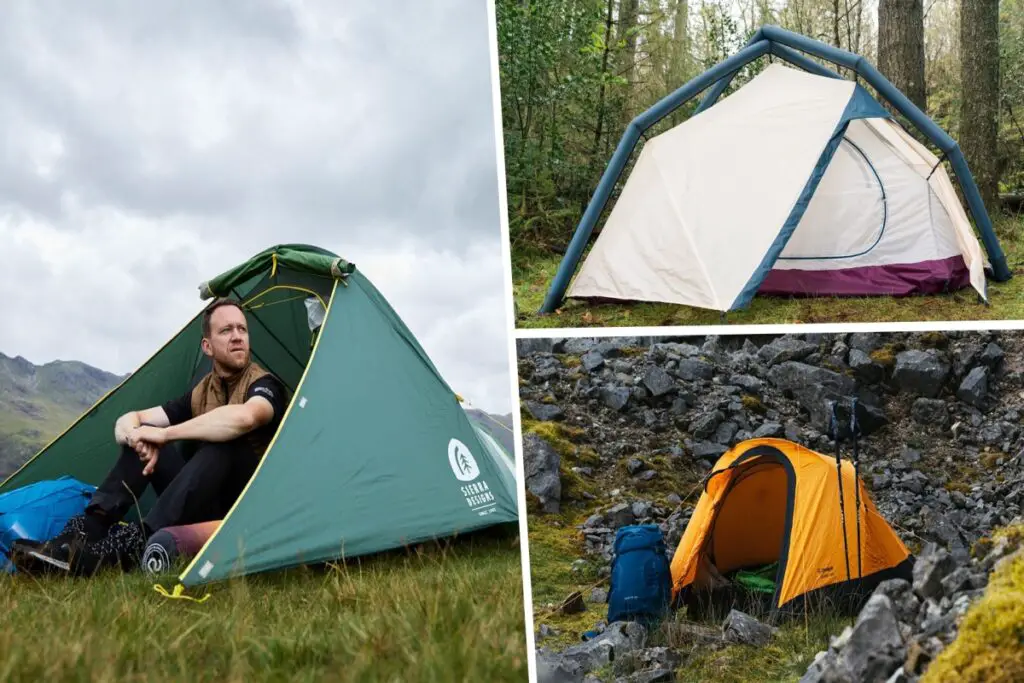
Key Features to Look for in a 2-Person Backpacking Tent
The weight of your gear, including the tent poles and flooring, is a crucial factor to consider.
A heavy tent, weighing in pounds or ounces, can quickly become a burden on your back, making it difficult for you to hike long distances.
Therefore, the weight (in lb) and packed size of a 2-person (2p) backpacking tent, along with its pole and floor, are essential features that you must look for when selecting one.
The ideal backpacking tent should be lightweight, weighing only a few lbs and ounces, and compact enough to fit into your backpack without taking up too much space or adding too much weight.
It should also have sturdy poles for easy setup and a durable floor to protect against rough terrain.
A good rule of thumb is to aim for a tent that weighs no more than 4-5 pounds (or lbs) and has a packed size of around 20 inches by 8 inches.
It’s also important to consider the tent’s floor, which should be durable enough to withstand wear and tear, and its overall weight in ounces (oz) for easy portability.
Roomy Interior: Ample Headroom and Generous Interior
Your backpacking tent should provide ample headroom, generous interior space, and large doors that allow easy entry and exit.
Additionally, it should have a sturdy floor to protect you from the ground, weigh no more than a few ounces or pounds, and be lightweight for easy carrying.
The camping tent interior space should be roomy enough to accommodate a 2p person tent comfortably while providing enough floor storage space for your gear.
A spacious interior with a sturdy floor ensures that you have enough room to move around freely inside the tent without feeling cramped or claustrophobic.
The tent’s lightweight design at only a few oz means you won’t be weighed down when carrying it, as it only adds a few lb to your load.
Having larger doors does not affect the floor, oz, weight, or lb of the tent but it makes it easier for you to get in and out of the tent without disturbing your partner.
Packed Weight and Floor Dimensions: Key Attributes You Must Look For
The packed weight in oz and floor dimensions of a 2-person backpacking tent are crucial factors that determine its suitability for use on extended trips.
The packed weight refers to the total weight of the tent when it’s fully assembled, including all poles, stakes, guylines, and floor.
On the other hand, floor dimensions and weight refer to the length, width, and heaviness of the ground area covered by the tent when set up.
Ideally, you should look for a 2-person backpacking tent with a packed weight of around 3-4 pounds and floor dimensions of at least 84 x 50 inches.
Duplex Design and Quality of Materials: Additional Features to Consider
The weight, duplex design, and quality of materials used in the construction of a 2-person backpacking tent, including the floor, are additional features that you must consider when selecting one.
A duplex design with a lightweight floor provides two separate entrances, allowing you and your partner to enter and exit the tent without disturbing each other.
Moreover, a high-quality tent made from durable materials with a sturdy floor ensures that it can withstand harsh weather conditions.
Such as strong winds, heavy rain, or snow, without adding too much weight to your camping gear.
Look for tents made from high-quality fabrics like nylon or polyester with waterproof coatings to ensure maximum protection against the elements.
Consider the weight and floor material for added convenience during camping trips.
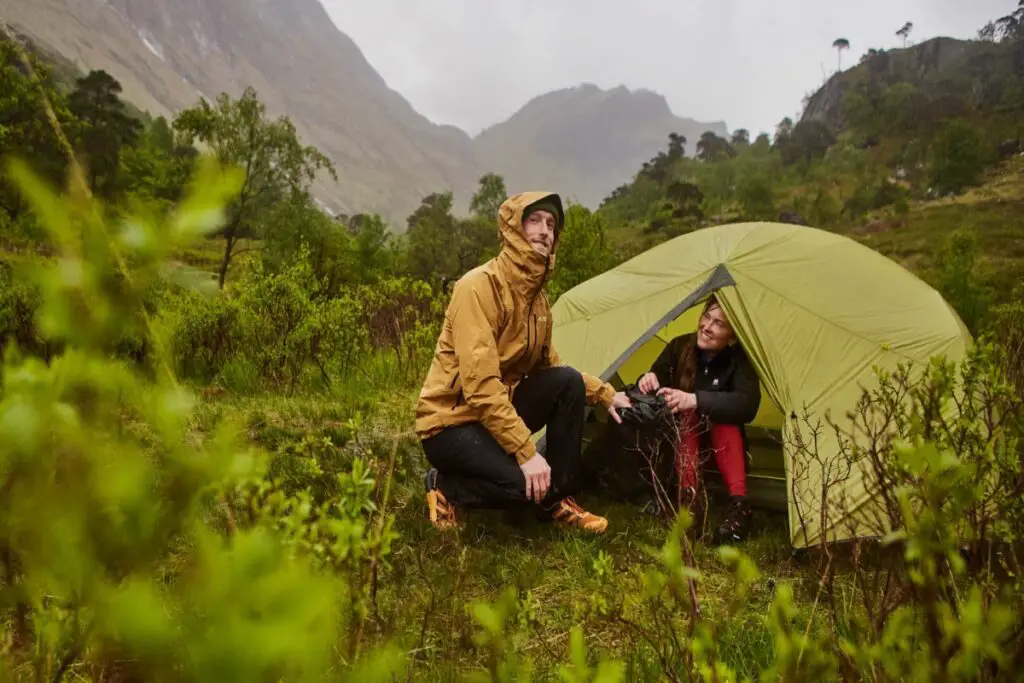
Budget-Friendly Options for the Best Value in a 2-Person Backpacking Tent
Backpacking is a fun and exciting way to explore the great outdoors.
However, if you’re on a tight budget and looking for a lightweight backpacking tent with a durable floor, finding the right one can be challenging.
Fortunately, there are many camping tent options available that offer excellent value without breaking the bank.
Whether you’re looking for a 2 person tent or a larger option, weight and floor space are important factors to consider.
Lightweight and Ultralight Backpacking Tent Options for 2 Persons
Weight and floor are everything. Carrying a heavy tent with a bulky floor can quickly become exhausting, especially when you’re hiking long distances.
That’s why it’s essential to choose a lightweight or ultralight option with a durable floor that won’t weigh you down.
One of the best options for a two-person backpacking tent with a sturdy floor is the MSR Freelite.
This budget-friendly option has an around-packaged weight of just 3 lbs. 7 oz., making it one of the lightest tents on the market.
Coverage Fly: A Feature to Consider When Looking for a Budget Tent
Another feature to consider when looking for a budget backpacking tent is weight.
A lightweight tent can help reduce the weight of your backpack, making it easier to carry during long hikes.
Additionally, a coverage fly provides extra protection from rain and wind and helps keep your gear dry in wet conditions.
Many budget-friendly tents come with coverage flies included, with some weighing less than 5 pounds.
For example, the ALPS Mountaineering Lynx 2-Person Tent features a full-coverage fly that provides excellent protection from rain and wind without adding significant weight.
Price Comparison of Budget Tent Options for 2-Person Backpacking Tents
Price and weight are always important considerations when choosing a camping tent.
Fortunately, there are many affordable options available that offer excellent value for a 2 person tent with a lightweight tent body.
For example, the Coleman Sundome 2-Person Dome Tent is one of the most affordable and lightweight options on the market.
Despite its low price point, this lightweight tent offers many features typically found in more expensive models, such as an easy-to-set-up design and weather-resistant materials.
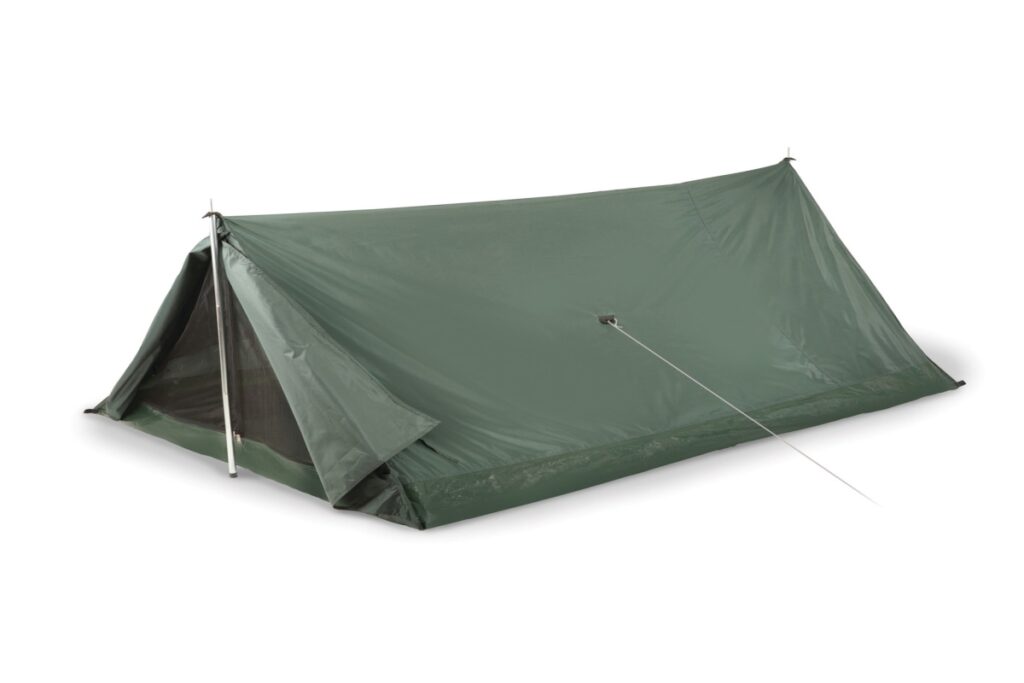
Tips for Choosing the Right 2-Person Backpacking Tent for Your Needs
Consider the tent’s weight and size to ensure it fits comfortably in your backpack. When choosing a 2-person backpacking tent, it is crucial to consider its weight and size.
You want a tent that is lightweight enough to carry on long hikes but still spacious enough to accommodate two people comfortably.
Most backpacking tents weigh between 2-5 pounds, so be sure to choose one that fits your needs without adding too much extra weight.
You should consider the packed size of the tent. A compact and lightweight tent will fit easily in your backpack and won’t take up too much space.
Keep in mind that smaller tents may sacrifice some interior space.
So make sure you choose one that offers enough headroom, legroom, and weight capacity for both you and your camping partner.
Look for tents with durable materials and strong poles to withstand harsh weather conditions. Backpacking can take you through various terrains and weather conditions.
So it’s essential to choose a tent made with durable materials that can withstand harsh outdoor environments without adding too much weight to your backpack.
Look for a tent with sturdy poles made from aluminum or fiberglass that can hold up against strong winds without adding too much weight.
The fabric of the tent should also be durable enough to resist tears, punctures, and abrasions while still maintaining a manageable weight for transportation.
Tents made from nylon or polyester are popular choices because they are lightweight yet tough.
Look for tents with waterproof coatings or rainflys to keep you dry during unexpected rainstorms.
Choose a lightweight tent with good ventilation to prevent condensation buildup and improve air circulation.
Good ventilation is crucial when backpacking in a small enclosed space.
Without proper airflow, the weight of condensation can build up inside the tent walls overnight, making everything damp.
This can lead to an uncomfortable sleeping experience or even mold growth if left unchecked.
To avoid adding too much weight to your gear, choose a lightweight 2-person backpacking tent with mesh windows or vents that allow fresh air in while keeping insects out.
These features will help prevent condensation buildup and improve air circulation, making for a more comfortable camping experience in a single person tent.
The tent body’s weight is also considered to ensure these features can be well fitted. Opt for a lightweight tent with easy setup features to save time, energy, and weight.
Setting up camp after a long day on the trail can be exhausting, so it’s essential to choose a 2-person backpacking tent that is easy to set up and won’t add unnecessary weight to your pack.
Look for tents with color-coded poles or freestanding designs that make assembly a breeze.
Some lightweight tents even have clips or hooks that allow you to attach the rainfly quickly.
Consider the number of stakes required to set up the tent. The weight of the stakes can affect the ease and speed of pitching your tent.
The fewer heavy stakes needed, the quicker and easier it will be to set up camp, especially in challenging conditions.
These small details can make all the difference when it comes to a successful camping experience.
Evaluate the tent’s storage options to keep your gear organized and protected, without adding unnecessary weight.
When camping in a backpacking tent, space is limited, so it’s essential to choose one with adequate storage options that won’t add extra weight to your pack.
Look for lightweight tents with interior pockets or gear lofts where you can store small items like flashlights or phones.
Vestibules are handy features that provide extra storage space outside of the main sleeping area.
Having designated storage areas will help keep your gear organized and protected from the elements while also maximizing interior space within your 2-person backpacking tent, without adding unnecessary weight.
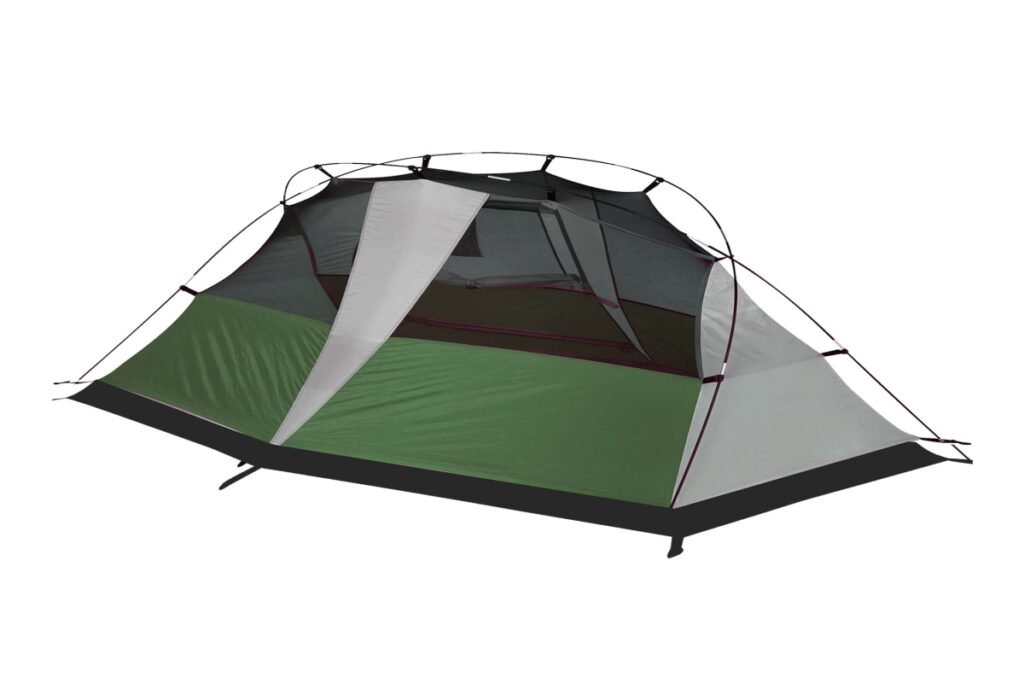
How to Properly Set Up and Maintain Your 2-Person Backpacking Tent
Setting up a 2-person backpacking tent can be daunting, especially if you’re new to camping.
The good news is that most tents come with manufacturer instructions that make setup a breeze.
When considering a tent, be mindful of the weight as it can impact your overall backpacking experience.
Before you head out on your trip, take some time to familiarize yourself with these instructions.
You’ll want to practice setting up your tent at home so that you’re comfortable doing it in the field.
When setting up your tent, it’s important to follow the manufacturer’s instructions exactly.
This will ensure that your tent is set up correctly and that it will provide adequate shelter from the elements.
If you have any questions about how to set up your tent, don’t hesitate to reach out to the manufacturer for assistance.
Choose a Level and Clear Campsite for Setup
Once you’re ready to set up your tent in the field, it’s important to choose a level and clear campsite.
Look for an area that is free of rocks, sticks, and other debris that could damage your tent or make sleeping uncomfortable.
You’ll also want to find an area that is relatively flat so that you don’t slide around during the night.
It’s also important to look for potential hazards when choosing a campsite.
Avoid setting up your tent near water sources such as rivers and streams as they can flood unexpectedly.
Similarly, stay away from dead trees or other unstable structures that could fall on your tent during high winds.
Regularly Check and Maintain Your Tent’s Stakes, Guylines, and Zippers
Finally, it’s essential to regularly check and maintain your 2-person backpacking tent while in use.
This means checking the stakes and guylines every day to ensure they are secure and tight.
Loose stakes or guylines can cause your tent to collapse or blow away during high winds. You should also inspect all zippers regularly for signs of wear or damage.
Broken zippers can make it difficult to get in and out of your tent, which can be a major inconvenience.
If you notice any issues with your zippers, try lubricating them with a silicone spray or contacting the manufacturer for replacement parts.
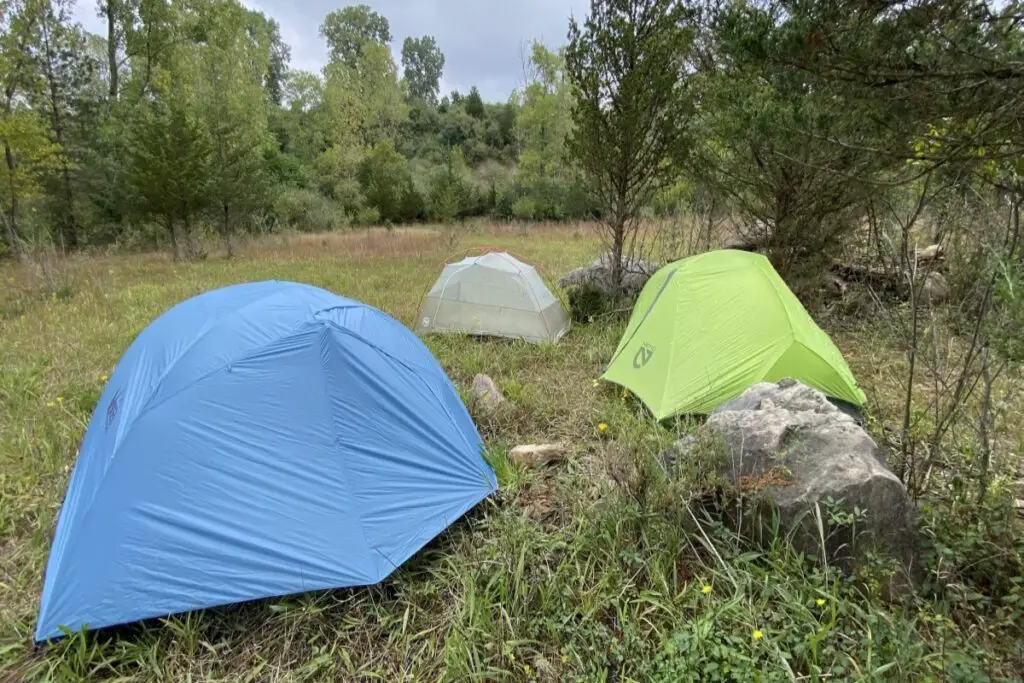
Frequently Asked Questions About 2-Person Backpacking Tents
The weight of a backpacking tent is one of the most important considerations when choosing one.
The Zpacks Duplex, which is designed for two people and their gear, weighs only 19 ounces (540 grams).
Making it one of the lightest camping tents available on the market, this person tent is perfect for backpackers who need to minimize their pack weight.
Its lightweight design makes it ideal for those looking for a lightweight camping tent.
Doors and vestibules in the Zpacks Duplex
The Zpacks Duplex has two doors and two vestibules, which is a rare feature in ultralight tents.
This means that both occupants can enter or exit the tent without disturbing each other.
Each person has their own storage space to keep their gear organized and dry. The vestibules are spacious enough to store a backpack or shoes.
Suitability of the Zpacks Duplex for all seasons
The Zpacks Duplex is a two-person tent designed to be used in three seasons – spring, summer, and fall – but it can also withstand light snowfall.
It’s not recommended for use in heavy snow or extreme cold conditions as it doesn’t have a four-season rating.
However, its waterproof rainfly made from Dyneema Composite Fabric (DCF) provides excellent protection against rain and wind.
Material used for the Zpacks Duplex’s rainfly
The rainfly of the Zpacks Duplex is made from DCF material, which is known for its strength-to-weight ratio and water resistance properties.
It’s highly durable and can withstand harsh weather conditions such as heavy rain and strong winds.
DCF fabric doesn’t stretch when wet like nylon does; therefore, there’s no need to adjust guylines during a storm.
Setting up the Zpacks Duplex without trekking poles
One unique feature of the Zpacks Duplex is that it requires trekking poles to set up.
However, if you don’t use trekking poles, you can purchase tent poles from Zpacks as an alternative.
Alternatively, you can use sticks or branches found in the wilderness as makeshift poles.
Finding the Perfect 2-Person Backpacking Tent for Your Next Adventure
The first thing you need to consider is the type of backpacking you’ll be doing.
Different backpacking tents are designed for different types of trips, so it’s important to choose one that suits your needs.
If you’re planning on doing some serious mountaineering or winter camping, then you’ll need a 4-season backpacking tent that can stand up to harsh weather conditions.
These tents are typically heavier and more durable than their 3-season counterparts, but they offer superior protection against wind, snow, and rain.
On the other hand, if you’re planning on doing some summer backpacking or car camping, then a lightweight 3-season backpacking tent will suffice.
These tents are designed for use in mild weather conditions and are much lighter and easier to carry than 4-season tents.
Look for a Lightweight Backpacking Tent
No matter what type of backpacking you’ll be doing, it’s important to choose a lightweight backpacking tent that won’t weigh you down on long hikes.
Look for a tent that is made from lightweight materials like nylon or polyester and has minimal poles and guy lines.
Many modern backpacking tents also come with hiking poles that can be used instead of traditional tent poles.
This not only saves weight but also makes your pack more versatile since hiking poles can be used for multiple purposes.
Consider the Size of the Tent
Another important factor to consider when choosing a 2-person backpacking tent is its size.
You want to make sure that the tent will comfortably fit two people and their gear without feeling too cramped.
Most 2-person backpacking tents have enough room for two sleeping bags and a few small pieces of gear.
But if you have larger items like hiking boots or bulky jackets, then you may want to look for a tent with extra storage space like a vestibule.
Look for Good Ventilation
One of the biggest challenges of camping in a tent is preventing condensation buildup inside the tent.
This can make your sleeping bag and clothes damp, which can be uncomfortable and even dangerous in cold weather.
To prevent condensation buildup, look for a backpacking tent with good ventilation.
Many modern tents have mesh panels that allow air to flow through the tent while still providing protection from bugs and other pests.
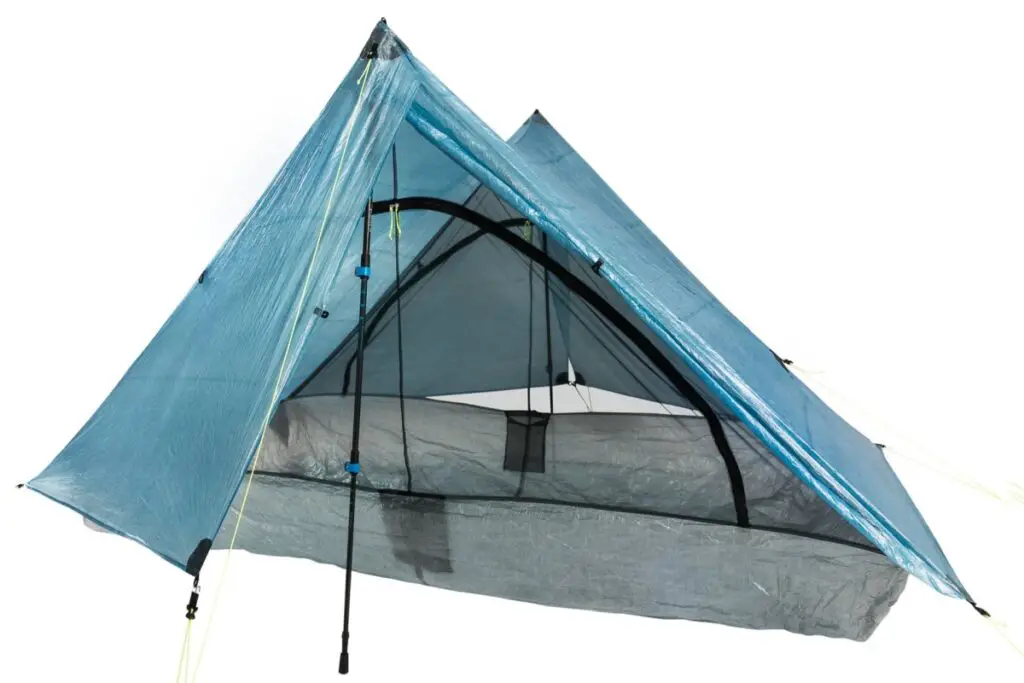
Additional Resources for Planning Your Next Backpacking Trip
Planning a backpacking trip can be both exciting and overwhelming. With so many options available, it’s important to do your research before hitting the trail.
Luckily, there are plenty of resources available to help you plan your next adventure.
One great resource is online guides specifically tailored to backpackers.
These guides can provide information on everything from trail conditions and difficulty levels to recommended gear and safety tips.
Some popular websites with comprehensive backpacking guides include Backpacker Magazine, REI Co-op Journal, and The Outbound Collective.
Another helpful tool for planning your trip is social media groups and forums dedicated to backpacking.
These communities allow you to connect with other backpackers who have first-hand experience on the trails you’re considering.
You can ask questions about gear, trail conditions, or even get recommendations for campsites or scenic spots along the way.
Zpacks for Lightweight and Durable Backpacking Gear
Weight is a crucial factor. The lighter your pack, the easier it will be to carry over long distances.
Zpacks is a popular brand among ultralight backpackers due to their lightweight yet durable gear.
Zpacks offers a variety of products including tents, sleeping bags, packs, and more – all designed with weight in mind.
Their tents are made with Dyneema fabric which is not only incredibly strong but also waterproof and lightweight.
Their sleeping bags use high-quality down insulation while still remaining lightweight enough for backcountry use.
Importance of Stuff Sacks for Organization and Maximizing Space in Your Pack
When packing for a backpacking trip, organization is key. Stuff sacks are an essential tool for keeping your gear organized while maximizing space in your pack.
Stuff sacks come in various sizes so you can separate different items such as clothing or food into their own sack.
This not only helps keep your pack organized but also makes it easier to find what you need without having to rummage through everything.
Stuff sacks can also help maximize space in your pack.
By compressing bulky items such as sleeping bags or clothing, you can free up extra space for other gear.
This is especially important for backpackers who have limited space in their packs and need to make every inch count.
Consideration of Trail Weight When Selecting Materials for Your Backpack
When selecting a backpack for your trip, it’s important to consider the weight of the pack itself.
The weight of the pack combined with all your gear can quickly add up and become a burden on long hikes.
One way to reduce the weight of your pack is by selecting materials that are lightweight yet durable.
Many backpacks are made with nylon or polyester which are both strong and lightweight materials.
Some backpacks have aluminum frames which provide support while still remaining relatively lightweight.
This is important because when you go backpacking, you have to carry everything on your back.
That means you want your backpack to be as light as possible so you don’t get tired too quickly.
But you also need it to be strong enough to hold all your stuff and keep it safe. That’s where the aluminum frame comes in!
It helps distribute the weight of your backpack evenly so it doesn’t feel too heavy on your shoulders.
Plus, it’s really durable so it can handle being bumped around on the trail.
The Benefits of Internal Pockets and Storage Pockets for Easy Access to Essential Items on the Trail
Internal pockets and storage pockets are another key feature to look for when selecting a backpack for your next trip.
These pockets provide easy access to essential items such as snacks, water bottles, or maps while on the trail.
Internal pockets are located inside the main compartment of the pack and provide additional organization options.
These pockets can be used to separate different items such as toiletries or electronics from your clothing or food.
Storage pockets are located on the outside of the pack and can be used to store items that you need quick access to such as snacks or water bottles.
Some packs even have stretchy mesh pockets which allow you to store larger items like rain jackets or hats without taking up space inside the main compartment.
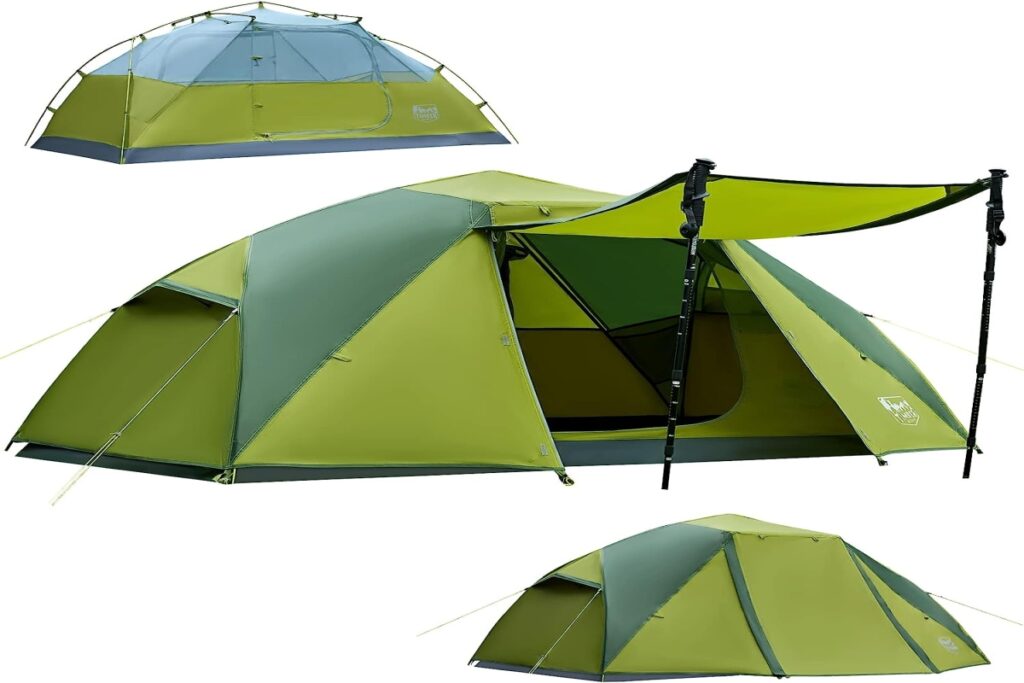
FAQ
1. How much does a 2 person tent cost?
Well, the cost of a 2 person tent can vary depending on the brand, materials used, and features it has. Some 2 person tents can cost around $50 to $100, while others can cost over $500!
2. How much should a 2 person backpacking tent weight?
When you go backpacking, it’s important to pack light so your backpack doesn’t get too heavy. That’s why it’s important to choose a 2 person backpacking tent that is lightweight. A good weight for a 2 person backpacking tent is around 3-4 pounds.
3. What is a good weight for a 2 person backpacking tent?
When you go backpacking, you want a tent that is light enough to carry on your back but also big enough for you and a friend. A good weight for a 2 person backpacking tent is between 3 and 5 pounds.
4. What is the best 2 person backpacking tent?
When you go backpacking, it’s important to have a good tent that is easy to carry. A 2 person backpacking tent is perfect for two people who are exploring the outdoors together.
5. What to consider when buying 2 person backpacking tents?
When you’re looking to buy a 2 person backpacking tent, there are some important things to think about. First, you want to make sure the tent is lightweight and easy to carry.
Conclusion
As you plan for your next backpacking adventure, choosing the right tent can make all the difference in your experience.
A lightweight and durable backpacking tent designed for two people can provide shelter, comfort, and convenience on the trail.
Consider key features such as weight, size, materials, weather resistance, ventilation, and ease of setup when selecting a 2-person backpacking tent that meets your needs.
Look for reputable brands that offer quality products with reliable customer support. Our top picks for 2023 include a range of options to fit different budgets and preferences.
From ultralight tents designed for minimalist backpackers to more spacious models with extra features like vestibules and gear lofts, there is something for everyone.
Remember to properly set up and maintain your tent to ensure it lasts through multiple trips.
This includes using a groundsheet or footprint to protect the bottom of your tent from wear and tear.
Properly staking it down in windy conditions, and storing it dry to prevent mold or mildew growth.
It’s important to make sure your backpacking tent stays in place, even when it gets windy outside. You can do this by using stakes to secure it to the ground.
And after you’re done using it, you should let it dry completely before packing it away. This will help prevent mold and mildew from growing inside your tent.

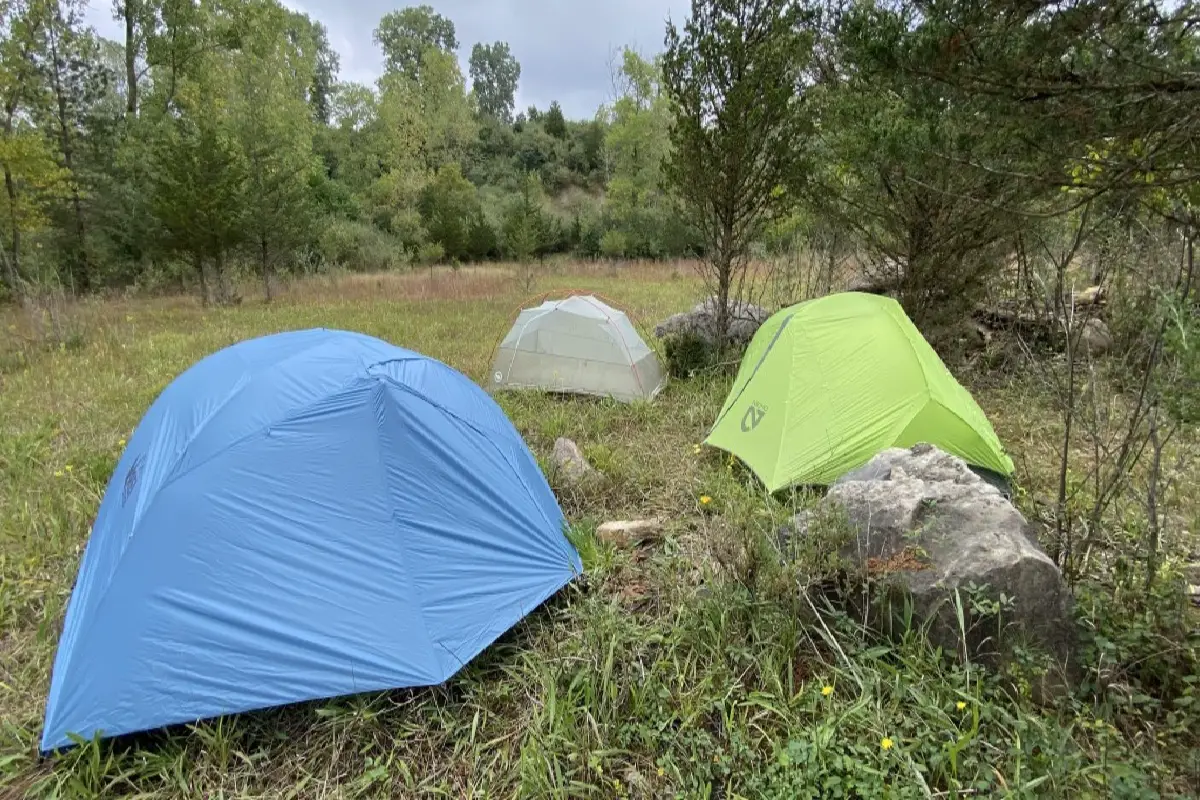







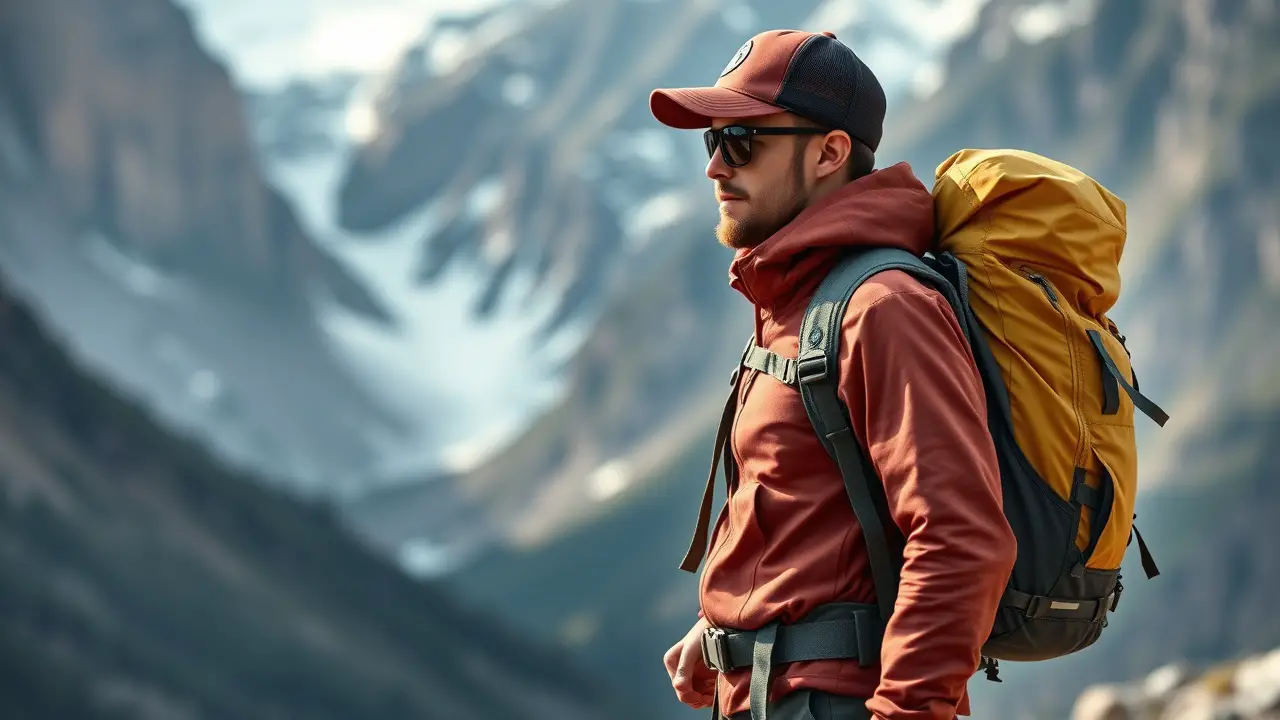
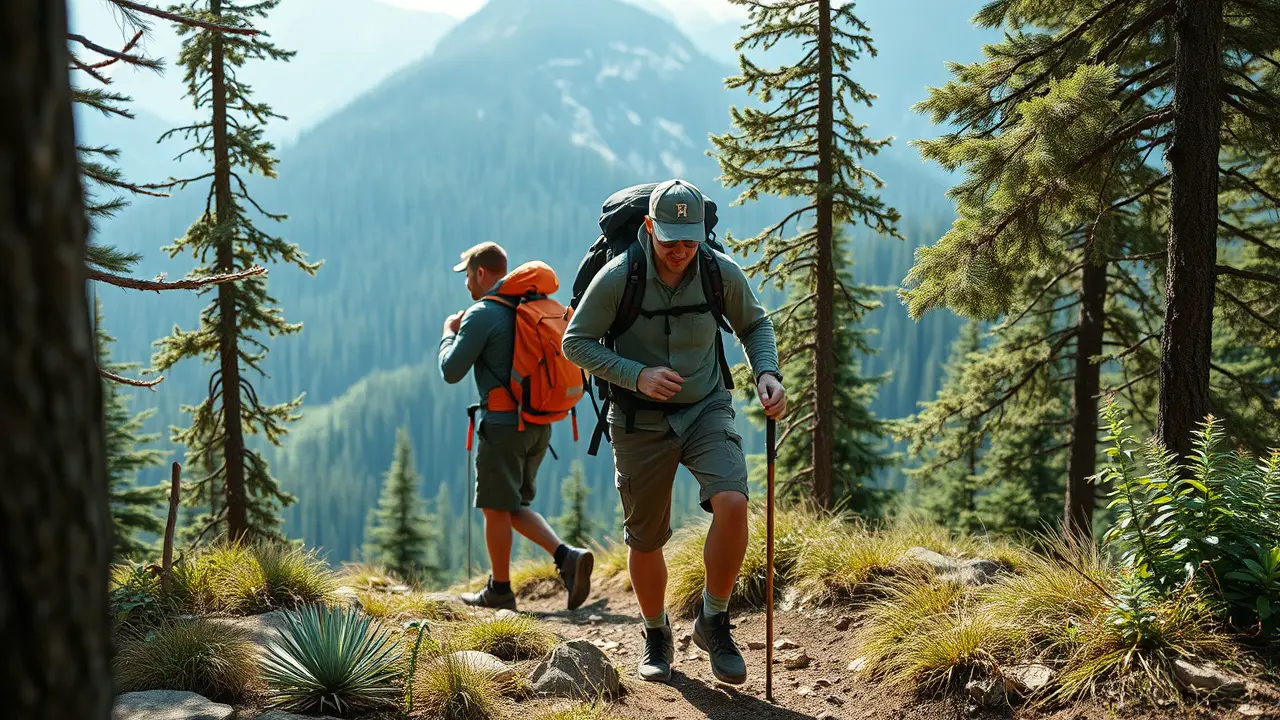
Leave a Reply